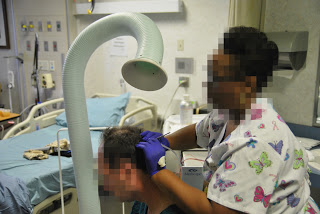
Collodion, a combination of nitrocellulose, ethyl ether, and ethanol, is a substance that is used for attaching electrodes to the head during EEG’s (Electroencephalography).
EEG’s are performed for a variety of medical reasons and are a primary research and diagnostic tool regarding electrical activity in the brain.
Electrodes must securely be attached to the scalp in order to be effective.
A manufacturer of Collodion explains that “Once the electrode is attached correctly monitoring can be performed continuously for days even if the patient is active and perspires.” [1]
The Occupational Safety & Health Administration (OSHA) describes ethyl ether as “a clear, colorless liquid with a characteristic, sweet ether odor.Some medical professionals believe that Collodion may cause a respiratory health concern because of the evaporation and subsequent fumes of one of its main ingredients: ethyl ether.
The air odor threshold concentration for ethyl ether is 8.9 parts per million (ppm) parts of air.” [2]
Toxicology. Effects on Humans
Ethyl ether has been used to produce surgical anesthesia in humans; the concentration that is needed to induce anesthesia in humans ranges from 100,000 to 150,000 ppm.
After anesthesia has been induced, it is maintained at about 50,000 ppm because respiratory arrest may occur at higher concentrations [Hathaway et al. 1991].
At 200 ppm, mild nasal irritation occurs, and at 2,000 ppm, dizziness may be experienced [ACGIH 1991; Hathaway et al. 1991].
Brief exposures of the eyes to the liquid or to high vapor concentrations produced burning but no injury.
Prolonged exposure may cause temporary corneal epithelial injury [Grant 1986].
Prolonged skin contact can cause burns.
Ethyl ether is also a defatting agent, and repeated exposure may cause skin drying and cracking [Genium 1988]. [2]
Signs and Symptoms of Exposure
1. Acute exposure: Ethyl ether causes a wide range of effects depending on the concentration and length of exposure. Symptoms include irritation of the nose and eyes, dizziness, acute excitement, drowsiness, vomiting, paleness, decreased pulse rate, decreased body temperature, irregular respiration, muscle relaxation, lung irritation with increased bronchial secretions, laryngospasm, loss of consciousness, and death [Clayton and Clayton 1982]. Post-narcosis effects include excessive salivation, vomiting, headaches, and irritation of the respiratory tract [Clayton and Clayton 1982].
Exposure Limits
OSHA’s permissible exposure limit (PEL) for ethyl ether is 400 ppm as an 8-hour time-weighted average (TWA).
The American Conference of Industrial Hygienists (ACGIH) also has a threshold limit value (TLV) of 400ppm for an 8-hour workday/40-hour work week and has a short-term exposure limit (STEL) of 500 ppm per 15 minutes. [2]
Process Enclosure
- Local Exhaust Ventilation- [Example: The Sentry Air Medical Fume Extractor]
- General Dilution Ventilation
- Personal Protective Equipment [2]
“Reducing the amount use: By applying collodion in tubes directly on the electrode sight you will be using only what you need, instead of dipping a gauze in a bowl on the tray/table.”
Using an exhaust fan.
Portable Fume Extractor System [Example: The Sentry Air Medical Fume Extractor]
Ozone Generator to dissipate the ethyl ether fumes in a room. [1]
 |
| Sentry Air Medical Fume Extractor [Model # SS-300-MED] being used for collodion application. |
Air quality sampling during Collodion use should be administered by a Certified Industrial Hygienist. For more information on Local Exhaust Ventilation options, call Sentry Air at 1.800.799.4609, email at sales@sentryair.com, or fill out this form to receive more information.

 Made in the USA
Made in the USA